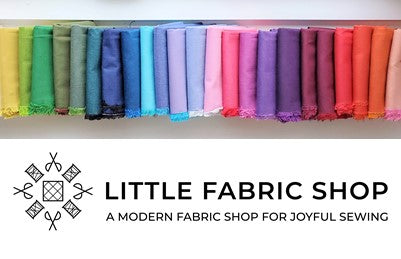How to Choose the Right Quilt Batting For Your Quilting Project

Compared to picking out the right pattern and selecting perfectly coordinating fabrics, choosing quilt batting for your project may seem like the easy part. However, quilt batting can make a huge difference in how your quilt looks and feels! It’s an important decision, so let us guide you in how to choose the right quilt batting for your beautiful sewing project.
Top things to consider when choosing quilt batting
Batting Material
The first and most important step is to choose a material for your quilt batting. Each type behaves a little differently, so here’s what you need to know in order to choose the best one for your specific project.
Cotton Batting
Cotton batting is a common choice for quilters because it’s lightweight and breathable, while still providing warmth in the winter. Cotton is also one of the most affordable choices for quilt batting.
Keep in mind, cotton shrinks 3–5% in the wash, so pre-shrink your cotton quilt batting to prevent any mishaps. Nobody wants their quilt to become lumpy and misshapen after spending hours sewing it together! It’s also important to note that cotton isn’t as resilient as other batting materials, so quilts stuffed with this batting may not hold their shape and may have more visible creases.
Polyester Batting
Polyester batting is great for winter blankets because it is very warm and resists mildew. Thicker than cotton, polyester batting will give your quilt a puffier appearance with less creasing. It comes in several different thicknesses, giving you more options than cotton, which usually only comes in 1/8th of an inch batting. Just know that if you want a flatter or more breathable quilt, then polyester may not be the ideal batting for you.
Cotton/Polyester Blend Batting
Maybe this goes without saying, but if you’re looking for something that is somewhere in between cotton and polyester batting, a cotton/polyester blend may fit the bill! Typically, these batting blends are 80% cotton and 20% wool, so you get most of the benefits of cotton and the added resilience of polyester and its plush loft (a quilting term for height).
Bamboo Batting
Bamboo batting is also technically a blend, usually consisting of 50% bamboo and 50% cotton. It’s also a great choice for eco-friendly quilters and fans of sustainable sewing materials. If you are quilting with a machine, this gentle material works very well. Like cotton, bamboo is breathable, and may also shrink when you wash it. Pre wash and dry this batting before stuffing your quilt to be safe.
Wool Batting
You can’t go wrong with wool batting if you want a quilt that stands the test of time. The main advantage of wool batting is that it is very warm but still lightweight. While this material is unlikely to shrink, keep in mind that it needs to be hand-washed, so choose a different batting if you want a low-maintenance quilt. It’s also another natural choice for the eco-friendly quilter or crafter.
Batting Processing
While some quilt battings will be left in their natural state, others are processed in certain ways that affect the way the batting performs. Here is what you need to know about common types of batting processing to make your decision.
Bonded
If the quilt batting is “bonded,” that means it has a small amount of glue in it. This holds the batting together better and makes it easier to work with. The end result is a quilt that stays lump-free or bare-spot free, longer. Be aware though, the bond can loosen in the washing machine, so if you plan on washing your quilt frequently (like one for a baby or child), you might want to use closer quilting lines so your project maintains the same look over time. If you use wool or polyester, look for a resin-bonded batting—it’s less prone to bearding!
Scrim
If your cotton batting has a scrim, that means there is an extra grid layer that helps it hold its shape while you work with it. If your quilting pattern has quilting lines that are far apart, you should use a batting with scrim.
Needle-Punched
Needle-punched batting is quilt batting that has gone through a type of felting process. The batting is “punched” repeatedly with needles which greatly strengthens the fibers. Look for needle-punched batting if you want something dense and with a lower loft. It will wear and wash better.
Other Considerations when Choosing Quilting Batting
By this point, you should have a pretty good idea of what to look for in quilt batting, but here are a few extra considerations that can help with your decision.
Color
Batting generally comes in three colors: bleached white, natural, and black. Use bleached batting for very light-colored fabrics, black batting for dark fabric quilts, and natural for anything in between. This helps reduce the visibility of any stray batting fibers (bearding) that may pop out of your quilt.
Size
You may know what kind of batting you want now, but how much do you need? Conveniently, you can often buy batting in standard bedding sizes (twin, queen, king, etc.). If not, you can always buy batting by the yard in a custom amount, just like you would with fabric. This comes in handy if you’re sewing baby blankets and quilts or custom throw quilts for antique beds.
When choosing the right quilt batting, there are many factors to consider. However, much of it comes down to personal preference, your quilt pattern, and how you will use your quilt. Yes, quilting involves a lot of planning at the beginning. Although, sewing your quilt is much more enjoyable when you make the right choices for your particular project! We hope this guide helps you do just that. Happy quilting!




